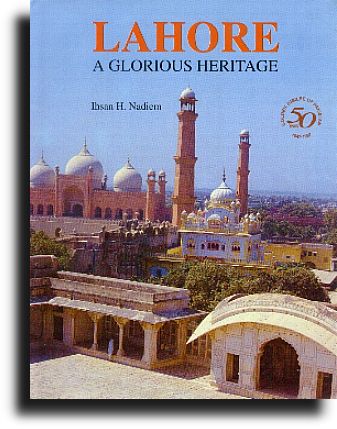
LAHORE (Punjabi: لہور, Urdu: لاہور pronounced [lahor]) is the capital of the Pakistani province of Punjab and is the second largest city in Pakistan after Karachi. It is popularly known as the Heart of Pakistan, due to its historical importance in the creation of Pakistan, and also being a cultural, political and educational centre of the country. It is also often called the Garden of the Mughals or the City of Gardens because of the heritage of the Mughal Empire. It is located near the Ravi River and Wagah, close to the Pakistan-India border. According to legend, Lahore was founded by Lao, son of Lord Rama of the Hindu epic Ramayana.
Much of Lahore's architecture from the Mughal and colonial eras has been preserved. Mughal structures such as the Badshahi Mosque, Ali Hujwiri, Lahore Fort, Shalimar Gardens and the mausoleums of Jehangir, and Nur Jehan are popular tourist spots in the city. Colonial British structures such as the Lahore High Court, General Post Office (GPO) and many of the older universities still retain their Mughal-Gothic style.
Punjabi is the native language of the province and is the most widely-spoken language in Lahore and rural areas. Urdu and English, however, are becoming more popular with younger generations since they are officially supported, whereas Punjabi has no official patronage. Many people of Lahore who speak Punjabi are known as Lahori Punjabi due to their use of a mixture of Punjabi and colloquial Urdu. According to the 1998 census, Lahore's population was nearly 7 million. Mid-2006 government estimates now put the population at approximately 10 million.[2] This makes Lahore the second largest city in Pakistan, fifth largest city in South Asia and the 23rd largest city in the world.
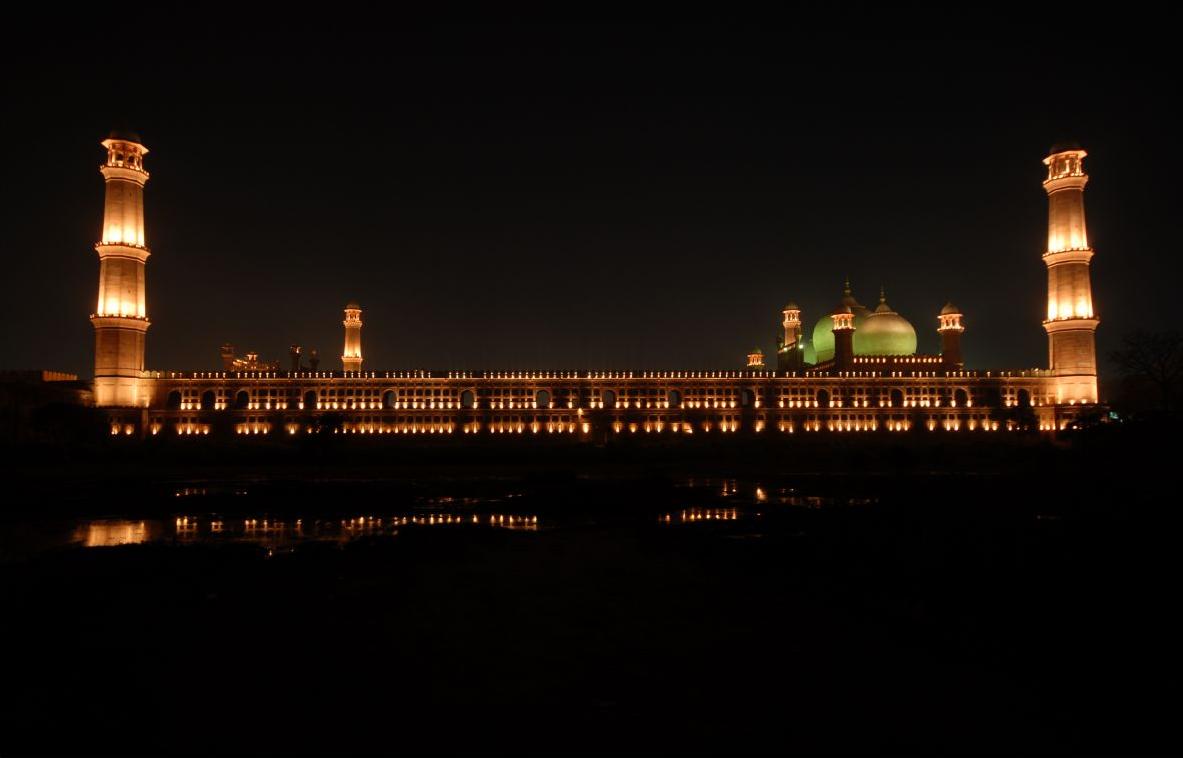
The Badshahi Mosque (Urdu: بادشاھی مسجد), or the 'Emperor's Mosque', was built in 1673 by the Mughal Emperor Aurangzeb in Lahore, Pakistan. It is one of the city's best known landmarks, and a major tourist attraction epitomising the beauty and grandeur of the Mughal era.
Capable of accommodating over 55,000 worshipers, it is the second largest mosque in Pakistan, after the Faisal Mosque in Islamabad. The architecture and design of the Badshahi Masjid is closely related to the Jama Masjid in Delhi, India, which was built in 1648 by Aurangzeb's father and predecessor, emperor Shah Jahan.
Badshahi Masjid is one of the locations where Qari' Abdul Basit recited the Qur'an.[citation needed] The Imam-e-Kaaba (Sheikh Abdur-Rahman Al-Sudais of Saudi Arabia) has also led prayers in this mosque in 2007.
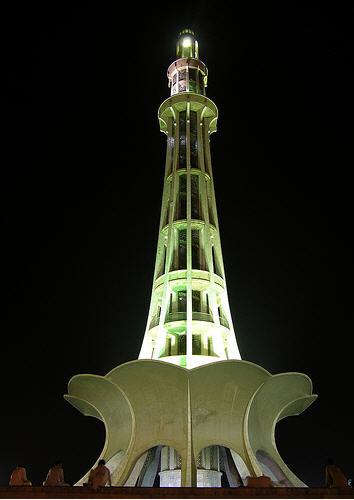
Minar-e-Pakistan
In the middle of Iqbal Park in Lahore stands Minar-e-Pakistan, a tall concrete minaret which was built as a tribute to the creation of Pakistan.
This is the exact place where in 1940, the Muslim League passed the famous Lahore Resolution, which demanded a separate homeland for the Muslims of India.
Minar-e-Pakistan is about 60 meters in height. The tower base is raised approximately four meters from the ground and it rises up to approximately 13 meters, forming a sculpted, flower-like base. From this point it tapers as it rises. The base platform is shaped like a five-pointed star and it encloses crescent shaped pools. It is constructed of reinforced concrete, with the floors and walls rendered in stone and marble. Now it is officially recognized as the National Monument of Pakistan.
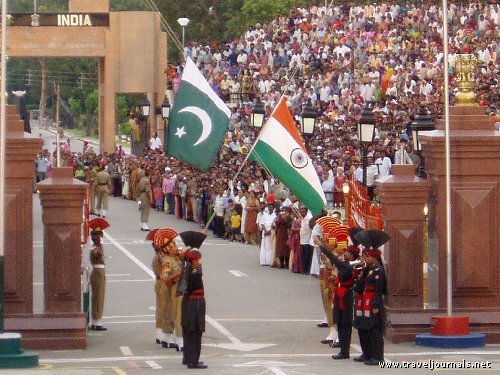
Wagah (Hindi: वाघा, Urdu: واہگہ, Punjabi: ਵਾਘਾ) is the only road border crossing between India and Pakistan, and lies on the Grand Trunk Road between the cities of Amritsar, India and Lahore, Pakistan.
Wagah itself is a village where the controversial Radcliffe Line was drawn. The village was unified before partition in 1947. Today, the eastern half of the village remains in India whilst the other half is in Pakistan.
The Wagah border is a ceremonial border where each evening, there is a ceremony called 'lowering of the flags'. At that time there is very energetic and thrilling parade done by Border Security Force (B.S.F), India and Pakistan Rangers soldiers. It may seem slightly aggressive to foreigners, but it really is just entertainment for the crowds from both sides. Border officers from the two countries sometimes walk over to the offices on the other side for day to day affairs. A bus service operating within the partitioned state of Punjab between Amritsar and Lahore was started in 2004, as relations between the two countries
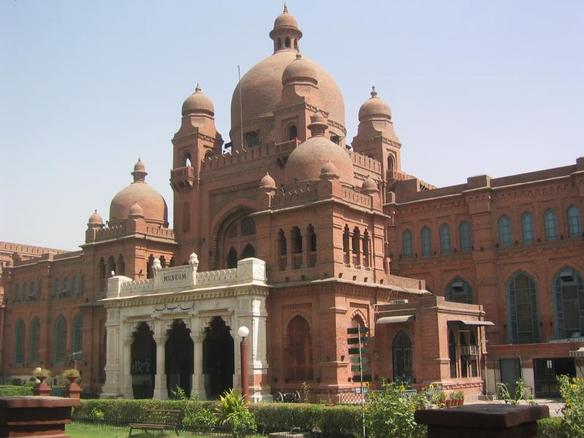
Lahore Museum was established in 1894 in Lahore, Pakistan, and is one of the major museums of South Asia. Lahore Museum is also known as Central Museum, and is located on The Mall. Rudyard Kipling's father John Lockwood Kipling, was one of the famous curators of the museum and the novel Kim was set in the vicinity of the Lahore Museum. Over 250,000 admissions were registered in 2005.[1]
It is located opposite the old University Hall, a Mughal-style building on the Shahrah-e-Quaid-e-Azam. The Museum contains some fine specimens of Mughal and Sikh door-ways and wood-work and contains a large collection of paintings dating back to the Mughal, Sikh and British eras.
The Museum has also a collection of musical instruments, ancient jewellery, textiles, pottery and armory. There are relics from the Graeco-Bactrian times as well as well as some Tibetan and Nepalese work. The museum has a number of objects of Greco-Buddhist sculptures, Mughal and Pahari paintings on display. The Fasting Buddha is one of the unique collections of the museum — in 2004 Nobuaki Tanaka, the Japanese ambassador, agreed to provide technical know how as the Buddha is popular with Japanese tourists
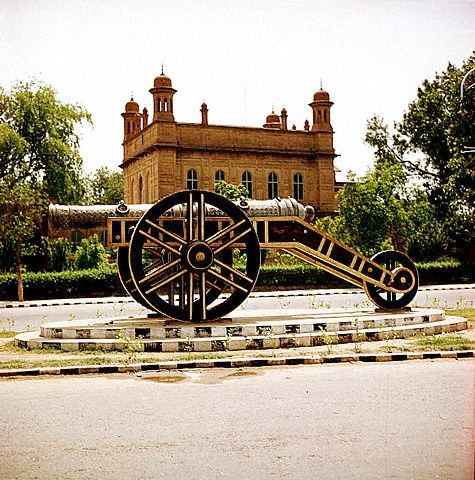
The Zamzama Gun, also known as Kim’s Gun or Bhangianwala Toap is a large bore cannon. It was cast in 1757 in Lahore, now in Pakistan but at the time part of the Durrani Empire. It is currently on display in front of the Lahore Museum in Lahore, Pakistan.
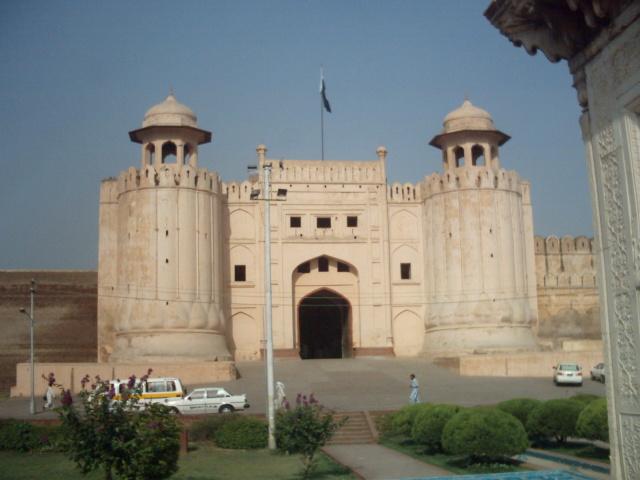
The Lahore Fort, locally referred to as Shahi Qila (Urdu: شاهی قلعہ ) is citadel of the city of Lahore, Punjab, Pakistan. It is located in the northwestern corner of the Walled City of Lahore. The trapezoidal composition is spread over 20 hectares. Origins of the fort go as far back as antiquity, however, the existing base structure was built during the reign of Mughal emperor Akbar (1556-1605), and was regularly upgraded by subsequent rulers. Thus the fort manifests the rich traditions of the entire Mughal architecture.[1] Some of the famous sites inside the fort include: Sheesh Mahal, Alamgiri Gate, Naulakha pavilion, and Moti Masjid. In 1981, the fort was inscribed as a UNESCO World Heritage Site along with the Shalimar Gardens (Lahore).